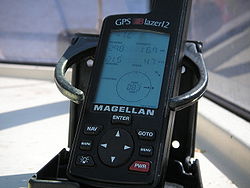GPS signals

GPS signals are broadcast by Global Positioning System satellites to enable satellite navigation. Receivers on or near the Earth's surface can determine location, time, and velocity using this information. The GPS satellite constellation is operated by the 2nd Space Operations Squadron (2SOPS) of Space Delta 8, United States Space Force.
GPS signals include ranging signals, used to measure the distance to the satellite, and navigation messages. The navigation messages include ephemeris data, used to calculate the position of each satellite in orbit, and information about the time and status of the entire satellite constellation, called the almanac.
There are four GPS signal specifications designed for civilian use. In order of date of introduction, these are: L1 C/A, L2C, L5 and L1C.[1] L1 C/A is also called the legacy signal and is broadcast by all currently operational satellites. L2C, L5 and L1C are modernized signals, are only broadcast by newer satellites (or not yet at all), and as of January 2021[update], none are yet considered to be fully operational for civilian use. In addition, there are restricted signals with published frequencies and chip rates but encrypted coding intended to be used only by authorized parties. Some limited use of restricted signals can still be made by civilians without decryption; this is called codeless and semi-codeless access, and is officially supported.[2][3]
The interface to the User Segment (GPS receivers) is described in the Interface Control Documents (ICD). The format of civilian signals is described in the Interface Specification (IS) which is a subset of the ICD.
- ↑ "New Civil Signals". Retrieved 2021-01-18.
{{cite web}}: CS1 maint: url-status (link) - ↑ "Codeless/Semi-Codeless GPS Access Commitments".
- ↑ Civilian GPS Receivers Actually do Have Access to the L2 Frequency
